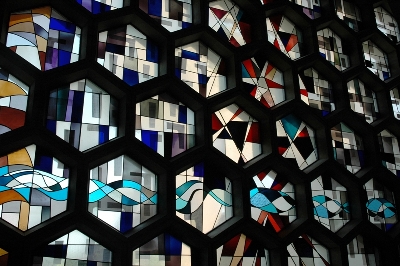He was a favorite to many students at Georgia Southern during his years in Statesboro (1973-1981). An engaging professor, he was as much a philosopher as an artist. He approached teaching as he approached his work - in pursuit of truth. As an artist his explorations took many paths, testing ideas and applying his design theories in both the realm of abstract and figurative art. Bronislaw Bak was a thinking man's artist whose considerable legacy continues to engage people long after his passing.
 He was born in 1922 in Leszno, a small town in Poland, where his mother was the librarian. At the age of 17 he became a cadet in the Polish army, on the eve of World War II. He fought against the German invasion of Poland in 1939 and was captured and forced into slave labor in German fields and factories until 1943. Escaping to Poland, he was recaptured by the SS, beaten and thrown into the Shirmeck concentration camp in Vichy France where he remained until he was freed by American troops in 1945. The Shirmeck concentration camp was a "reeducation camp" for resisters from occupied lands throughout Europe, a number of whom ended up in the Nazweiler_Struthof death camp 10 kilometers away.
He was born in 1922 in Leszno, a small town in Poland, where his mother was the librarian. At the age of 17 he became a cadet in the Polish army, on the eve of World War II. He fought against the German invasion of Poland in 1939 and was captured and forced into slave labor in German fields and factories until 1943. Escaping to Poland, he was recaptured by the SS, beaten and thrown into the Shirmeck concentration camp in Vichy France where he remained until he was freed by American troops in 1945. The Shirmeck concentration camp was a "reeducation camp" for resisters from occupied lands throughout Europe, a number of whom ended up in the Nazweiler_Struthof death camp 10 kilometers away.
After the war he studied art in Mannheim, where he met his wife, Hedi. Hedi and Bronislaw were part of the first generation of art students in Germany after the war. Up until the Nazi took power in 1933, Europe was the cultural center of the world and art flourished in Germany. Artists were banned, driven in exile and many killed during the Hitler era. The small community of artists, teachers and students who came together amid the rubble of post-war Germany were inspired and grounded in the methods and ideas of an earlier epoch. Bronislaw and Hedi brought this lifelong passion for the pursuit of art to their adopted homeland in 1952. Bronislaw left a 30 year legacy of architectural commissions, paintings, sculpture and fine prints.
His signature work was completed in 1961. The massive stained glass window wall, embedded in the concrete hexagons of St. John's Abbey Church in Collegeville Minnesota remains one of the most significant works of it's kind in the world. The window was designed and executed by the artist in the space of less than 3 years.  Working with a few monks and students in a drafty old dairy barn on campus, the project was both a triumph and a disappointment to the artist. The window and artist became the focus of a struggle of wills between factions within the local church hierarchy, that eventually even drew in the world famous architect, Marcel Breuer. The protagonists of that generation have nearly all passed on, and the window still stands in all it's glory. An article in Stained Glass Magazine in 1994 strongly urged the art world to acknowledge the importance of this massive work of art.
Working with a few monks and students in a drafty old dairy barn on campus, the project was both a triumph and a disappointment to the artist. The window and artist became the focus of a struggle of wills between factions within the local church hierarchy, that eventually even drew in the world famous architect, Marcel Breuer. The protagonists of that generation have nearly all passed on, and the window still stands in all it's glory. An article in Stained Glass Magazine in 1994 strongly urged the art world to acknowledge the importance of this massive work of art.


















